| Pages:
1
2
3
4 |
The WiZard is In
International Hazard
    
Posts: 1617
Registered: 3-4-2010
Member Is Offline
Mood: No Mood
|
|
...who accidentally trod on a quantity of fulminating silver
had his foot nearly destroyed by the explosion.
The American journal of science, & c, Volume 1. 1818.
ART. XVI. Cautions regarding Fulminating Powders. Fulminating Mercury.
Google.com/books
DURING a late lecture in the laboratory of Yale College, a quantity of fulminating
mercury, probably about 100 or 150 grains, lay upon a paper, the paper lay on a
small stool, which was made of pine plank, one inch and a half thick; a glass gas
receiver, 5 or 6 quarts capacity, stood over the powder, as a guard, but without
touching it, and stool and all stood on one of the shelves of the pneumatic
cistern, surrounded by tall tubes and other glasses, several of which were within
6 or 8 inches. A small quantity of the fulminating powder, at the distance of a few
feet, was merely flashed, by a coal of fire, but without explosion. In a manner,
not easily understood, the whole quantity of powder under the large glass
instantly exploded with an astounding report; but the glass was not exploded—it
was merely thrown up a little : in its fall it was shattered, and broke a glass which
it hit, but no fragment was projected, and none of the other contiguous tubes and
glasses were even overset, nor were any of a large audience, and some of them
very near, even scratched; but the plank, one and a half inch thick, on which the
powder lay, had a hole blown quite through, almost as large as the palm of one's
hand. This is a striking instance to prove that the initial force of this powder,
when exploded, is very great, but that it extends but a very little way. If it be
strewed through a glass tube of three-fourths of an inch in diameter, and
exploded by a coal of fire or hot iron, the tube may be held in the naked hand,
and the powder only flashes without breaking the tube, and merely coats it over
inside, and that very prettily, with the revived quicksilver.
Fulminating Silver.
Chemists are too well acquainted with the tremendous energy of this
preparation, to make any comment upon its powers necessary. Unhappily,
however, it is now made a subject of amusement; it is prepared for sale by those
who know nothing of it, except as a nostrum, and it is bought by others who have
not even this degree of knowledge. It is true it is put up in small quantities, in the
little toys called torpedoes, and, if exploded one by one, they will ordinarily do no
harm ; but as they fall into the hands of children, we can never be secure that
they will be discreetly used.
A very severe accident, from the unexpected explosion of this substance,
occurred some years since in the laboratory of Yale College. (See Bruce's
Journal, Vol. I. p. 163.) And, notwithstanding that this occurrence was well known
in New Haven, the same accident, only under a severer form, has again
occurred in that town.
A man who had bought the secret of making fulminating silver, had prepared
as much as resulted from the solution of one ounce and a half. Apparently, in a
great measure, unaware of the nature of the preparation, he had placed it,
unmixed with any thing, on an earthen plate, which stood on a table ; his wife
and children being around, he sat down to distribute the powder upon several
papers which he had prepared for the purpose; Band and shot are mixed with
the powder in the papers for the purpose of giving momentum, and of producing
attrition when the torpedo is thrown, in order to ensure its explosion. Probably
also the sand, looking not very unlike the powder, may be intended to screen it
from view, and thus to preserve the secret, should the papers be opened. The
unhappy man no sooner touched the fulminating silver with a knife, than it
exploded with its nsual violence ; the table was split in two ; blood issued
copiously from every part of hit face, not from wounds, for it does not appear
that the fragments hit him, but, according to the opinion of a competent judge,
the blood was actually forced through the pores of the skin by the power of the
explosion, which very nearly destroyed his eyes. He suffered immensely, but
now, at the end of eight months, sees partially with one eye, but the other is
nearly, if not quite, destroyed.
Should not the tampering with such dangerous substances by ignorant people be
prevented by law ? . .
In a late lecture in the laboratory of Yale College, some fulminating silver, on
the point of a knife, was in the act of being put upon a copper-plate connected
with one pole of a galvanic battery in active operation, the other pole was not
touched by the experimenter : but it seems that the influence which was
communicated through the floor of the room was sufficient instantly to explode
the powder, as soon as the knife touched the copper-plate ; the knifeblade was
broken in two and one half of it thrown to a distance among the audience.
Recently also, we are informed, in one of the foreign journals, that a man in
England, who accidentally trod on a quantity of fulminating silver, had his foot
nearly destroyed by the explosion.
djh
---
For fools rush in where
angels fear to tread.
Alexander Pope
An Essay on Criticism
1711
|
|
|
Hennig Brand
International Hazard
    
Posts: 1284
Registered: 7-6-2009
Member Is Offline
Mood: No Mood
|
|
You always find some very interesting things to read. I agree that Silver Fulminate is some pretty dangerous stuff, however it would be even easier to
make the case, by referring to the literature, that nitroglycerine is far too dangerous to handle. Most people who have worked with nitroglycerine
find that it is not the boogeyman that it is so often made out to be, and that the dangers are easily managed if one has half a brain. I am not
suggesting that silver fulminate and nitroglycerine are the same.
In the last two days I have done about 8 syntheses of Silver Fulminate. What I found by just playing with the quantities and type of reagents was kind
of interesting. The biggest reason I was having trouble with decomposition during my prior attemps was because of too much HNO3. I also discovered
that it was possible to get good results with just ethanol and no acetone at all.
Here are a few pictures of one of the last processes. The silver used was sterling silver wire from a crafts shop which cost about $1.38 per gram.
Sterling silver is only 92.5% silver I believe. A half gram of the metal was used for each reaction.
Reagents:
5mL 65% HNO3
2mL deionized water
0.5g sterling silver
6mL+ 90-95% ethanol
Procedure:
The whole reaction was done outside.
Silver is weighed and cut into short sections with nippers before being put in a 50mL beaker. The 5mL of HNO3 and 2mL of deionized water are added to
the same beaker. The beaker is placed on a hotplate on low heat to help dissolve the silver (red gas can be seen escaping from the beaker, do not
breath in).
A green solution (from copper in sterling silver) can be seen after the silver has all dissolved. Take the beaker off the heat and pour the contents
into a larger beaker ( the first time I didn't use a larger beaker and it boiled over ruining the reaction and making a mess). While still warm add
6mL of ethanol all at once. The reaction may start on its own, but usually needs to be placed back on the heat (small bubbles can be seen forming at
the start of the reaction after a minute or two of gentle heating). IIRC the reaction starts somewhere around 60C. Once the reaction starts the beaker
can be taken off the heat as the reaction generates its own heat and is self sustaining. Small amounts ~1mL of ethanol are added a couple to a few
times to moderate the reaction rate and to make up for evaporative losses during the reaction.
The whole reaction takes around 5-10 minutes.
Gentle supplemental heating can be applied near the end of the reaction to drive it more to completion, however most of the reaction is done I believe
at this point anyway.
At the end of the reaction the reaction mixture is diluted well with deionized water, the precipitate filtered out and rinsed repeatedly with more
deionized water before being allowed to air dry.
Three different types of ethanol were used, 95% absolute ethanol, 95% denatured, and my own homemade which measures as 90% with a hydrometer. The
absolute seemed to give the best results with 0.49g of silver fulminate from 0.5 gram of sterling silver. The denatured and homemade both gave between
0.4 and 0.45g.
With the smaller quantity and lower concentration of HNO3 in the reaction mixture the reaction was very easy to control. When the reaction got too
violent and hot a little more ethanol was added which helped to dilute and cool the reaction. The volume of the reaction mixture was also kept from
getting too low from evaporation by adding a mL or so of ethanol from time to time. Initially 6mL of ethanol was added all at once at the beginning
before the start of the reaction.
In the last picture is the damp yeilds from the last two syntheses, once completely dry the clumps just fall into a pile of loose powder.
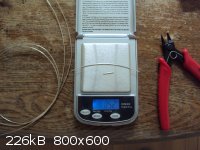 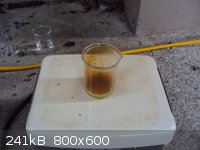 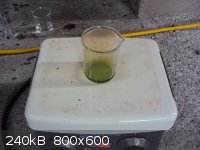 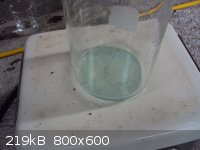 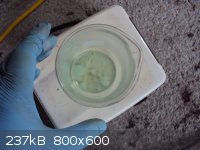 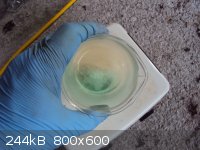 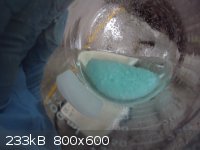  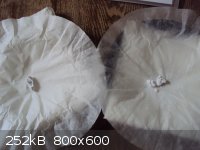
[Edited on 25-6-2011 by Hennig Brand]
|
|
|
Hennig Brand
International Hazard
    
Posts: 1284
Registered: 7-6-2009
Member Is Offline
Mood: No Mood
|
|
Just to see what would happen I took the extra 5 minutes and used gently heating to drive the silver fulminate reaction more to completion. I got a
yield of 0.57g from 0.5g of sterling silver, and I am pretty sure I could have gotten more if I was more patient. The first picture shows the yield on
the scales.
The larger beaker in the picture above is a 400mL beaker, which I tilt slightly so the small volume reaction mixture sits in the bottom corner. To
apply gentle heating the beaker is held above the hotplate an inch or two, while the hotplate is on fairly low heat (position 2 out of 7).
I also dug out an old sample of silver fulminate which is about 2 years old. It was kept at ordinary room temperatures, and in a dark container out of
light. As you can see it has gotten quite a bit darker in color. I find the freshly made stuff has a little bit more zing in bang snaps, but the old
stuff still works pretty damn well. The difference probably wouldn't be noticable unless compared one after the other. My testing methods are very
primitive, but I can say it hasn't lost its main qualities. I suppose I could do some simple witness plate type testing or something.
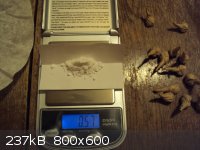 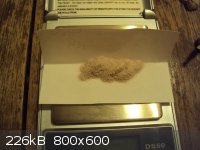
[Edited on 1-7-2011 by Hennig Brand]
|
|
|
quicksilver
International Hazard
    
Posts: 1820
Registered: 7-9-2005
Location: Inches from the keyboard....
Member Is Offline
Mood: ~-=SWINGS=-~
|
|
The color change looks fairly obvious even with the golden "over-hue" of the surrounding picture. - That the only intervening factor appears to be
time (no UV, etc) IS odd. But then silver salts may change in very subtle temp or moisture situations. I have seen Ag azide alter a bit from mild
temp.
I really don't know of a way to test for energetic characteristics without old-time mechanisms such as a miniaturized pendulum, etc. A witness plate
would have to be miniaturized to a point where visual differences would be tough to distinguish. If there was a method to make a scale that fixed at a
peak of driven energy that may work. But it would have to survive shock that might damage any device of sensitivity.
|
|
|
Rosco Bodine
Banned
Posts: 6370
Registered: 29-9-2004
Member Is Offline
Mood: analytical
|
|
Ooooh oooooh the supernatant sure is a pretty baby blue 
http://www.youtube.com/watch?v=TkA7xQb6uPk Badfinger - Baby Blue
|
|
|
Hennig Brand
International Hazard
    
Posts: 1284
Registered: 7-6-2009
Member Is Offline
Mood: No Mood
|
|
If a person could keep their sensitive body parts out of harms way, a small amount could be pressed into a small paper or soft plastic tube. Witness
plate tests are performed with blasting caps, so make a small cap out of each silver fulminate sample (more than one of each would even be better).
Try to keep everything as much the same for both caps as possible (use as much precision as possible). Do you think that might work?
As long as I kept the sensitive parts of my anatomy out of the way, and used casings that wouldn't create shrapnel in the event of a premature
detonation, I wouldn't mind pressing a little silver fulminate.
The dark color is kind of an odd thing. Every sample I have kept around has gone dark, the more light its exposed to the quicker the darkening though.
That copper nitrate blue is very pretty, isn't it? Apparently the copper nitrate in the concentrated solution makes a greenish solution, but after
dilution with alcohol and/or water it changes to that nice blue color.
Rosco and Quicksilver have most likely already seen this demo before, but I'll link to it anyway as it has a good set of pictures and descriptions
which I found useful and others might too.
http://www.angelo.edu/faculty/kboudrea/demos/copper_HNO3/Cu_...
[Edited on 1-7-2011 by Hennig Brand]
|
|
|
quicksilver
International Hazard
    
Posts: 1820
Registered: 7-9-2005
Location: Inches from the keyboard....
Member Is Offline
Mood: ~-=SWINGS=-~
|
|
The reason (obviously my opinion) why caps have been so successful in crude testing such as the "bent nail", etc are that one has more to work with
and the consistent design of the energetic in a physical embodiment. Some authors / writers (Abel) insist that silver fulminate has a substantial
friction sensitivity as opposed to mercury fulminate which has more impact sensitivity making the silver a much more dodgy thing to bring beyond a
gram level. I think it's just damn hard to work with. That friction sensitivity becomes very annoying due to free powder's inconsistent dent on the
plate. If I was to try it again I would make a tiny pellet w/ dextrin some smooth flexible polymer for a mold
-=Having samples that one knows the date of mfg is a valuable thing IMO.=-
Keeping copper nitrate truly dry is a challenge. I've once made some & used a "home-made H2SO4 drying bowl" to get those crystals as cleanly
divided as possible, yet the air within the small storage bottle was enough to provide deliquescense once more after a 24hr period.
|
|
|
Hennig Brand
International Hazard
    
Posts: 1284
Registered: 7-6-2009
Member Is Offline
Mood: No Mood
|
|
It may be just luck, but in the last few years and around 30 or 40 samples of silver fulminate, I found the sensitivity to be fairly consistent. I
suppose it is also possible for a little static electricity to catch me off guard in a careless moment and ruin my day. I have never had any problems
with silver fulminate yet, but I have a great deal of respect for it, and am very careful. Just the way it works in bang snaps speaks volumes about
its sensitivety.
I know the sample in the picture above was made 2 summers ago before the start of the school year, so I can say with certainty the sample is 2 years
old plus or minus 2 months. I should have put the date on the bottle, that is true.
Making a pellet with silver fulminate sounds like a good alternative to pressing.
|
|
|
quicksilver
International Hazard
    
Posts: 1820
Registered: 7-9-2005
Location: Inches from the keyboard....
Member Is Offline
Mood: ~-=SWINGS=-~
|
|
During a British military testing agenda at the turn of the 20th century the use of dextrin was employed to limit the friction potential; eventually
in the formation of a pellet via a method of tablet forming within an existing disposable mold. The best source of info on this was USBoM circulars
and what's left of the (public domain) British testing material. {note: most of that stuff is gone now & it's tough to find fresh any longer.}
I will look for some that I may have kept from old UseNet days. There WAS some testing on the initiation properties of SF as it appeared more
promising than mercury but the shelf-life issues with both were a serious impediment in the tropics and American climate. If I find it I post it. I do
have a lot of material on primaries.
|
|
|
KernelPicnic
Unregistered
Posts: N/A
Registered: N/A
Member Is Offline
|
|
Yesterday I made some silver fulminate with 3g silver nitrate dissolved in ~10ml water, 10ml ~80% nitric acid and 20ml 95% ethanol. I used a warm
water bath to heat it until it started bubbling, about 60C. The temperature then began to climb rapidly, reaching about 85C before I could get some
ice to cool it. The temp stabilized at about 65C and kept bubbling for 10 minutes or so. When the bubbling stopped, I added ~20ml of water, then
gravity filtered and washed with 30ml of water. I don't know what the yield was, but I estimate it was 1-1.5g.
I attempted to dry the wet crystals on a ceramic plate in a desiccator bag for a few hours, then realized it was probably a terrible idea and tried
to scoop the still soaking wet powder into a container of water. The entire yield then spontaneously detonated, obliterating the plate and sending
shrapnel everywhere. Most of it missed me, but I was hit with a few pieces in the forehead and both hands. I most likely didn't wash it nearly enough,
it still smelled strongly of alcohol and nitric acid when it was drying.
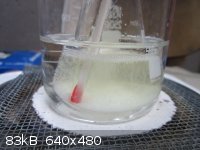 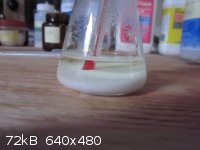 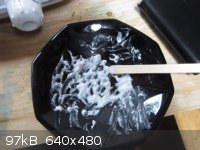
|
|
|
Davin
Harmless

Posts: 36
Registered: 5-12-2012
Member Is Offline
Mood: No Mood
|
|
Quote: Originally posted by KernelPicnic  | Yesterday I made some silver fulminate with 3g silver nitrate dissolved in ~10ml water, 10ml ~80% nitric acid and 20ml 95% ethanol. I used a warm
water bath to heat it until it started bubbling, about 60C. The temperature then began to climb rapidly, reaching about 85C before I could get some
ice to cool it. The temp stabilized at about 65C and kept bubbling for 10 minutes or so. When the bubbling stopped, I added ~20ml of water, then
gravity filtered and washed with 30ml of water. I don't know what the yield was, but I estimate it was 1-1.5g.
I attempted to dry the wet crystals on a ceramic plate in a desiccator bag for a few hours, then realized it was probably a terrible idea and tried
to scoop the still soaking wet powder into a container of water. The entire yield then spontaneously detonated, obliterating the plate and sending
shrapnel everywhere. Most of it missed me, but I was hit with a few pieces in the forehead and both hands. I most likely didn't wash it nearly enough,
it still smelled strongly of alcohol and nitric acid when it was drying.
|
OK. Silver fulminate has an insane friction sensitivity. Yet you have an image of a glass thermometer in a glass beaker with silver fulminate
between the two. Silver fulminate can detonate even under water from these conditions. Absolutely no glass on glass contact is acceptable when
working with silver fulminate.
Same with ceramic plate. A light touch with a plastic spatula on a ceramic plate is enough to set it off. Paper towels are far more appropriate.
Desiccators are also unnecessary. Just let it sit on some paper overnight.
|
|
|
nagyepf
Harmless

Posts: 49
Registered: 1-9-2017
Member Is Offline
Mood: No Mood
|
|
You might say that AgONC is extremely sensitive,and has no practical uses other than bang snaps.
But in old times it was actually used in blasting caps,silver azide too.
|
|
|
Aerostato
Harmless

Posts: 2
Registered: 24-11-2018
Member Is Offline
|
|
Hello everyone,
I'm new here, i study Chemistry and I'm from Italy.
In the last months, I've been looking for some chemicals to make photographic emulsion. Among these chemicals, I got some extra AgNO3 that I decided
to use to make AgCNO; so I easily got some absolute Ethanol too.
The problem is that I don't have any HNO3: is it necessary?
I thought that i can add some AgNO3 in Water:
AgNO3 --> Ag+(aq) + NO3-(aq)
And then add another Strong Acid, as HCl, to form Acid pH in solution.
Then add Ethanol and so on.
Do you think it coul work?
And if you think so, Does the acid need to be a Concentrade Acid or can I use commercial HCl (the one that you can find in supermarket)?
|
|
|
hissingnoise
International Hazard
    
Posts: 3940
Registered: 26-12-2002
Member Is Offline
Mood: Pulverulescent!
|
|
The synth. won't proceed without HNO3 and SF is way too sensitive for use as a primary ─ even handling it is inadvisable?
Better candidates would be acetylides and azides...
|
|
|
Aerostato
Harmless

Posts: 2
Registered: 24-11-2018
Member Is Offline
|
|
Could I ask you why? What's the role of HNO3 in the reaction?
|
|
|
hissingnoise
International Hazard
    
Posts: 3940
Registered: 26-12-2002
Member Is Offline
Mood: Pulverulescent!
|
|
The reaction to produce fulminic acid is dependent on the formation of nitro-nitroso intermediates and these only form by the action of
HNO3.
|
|
|
| Pages:
1
2
3
4 |
|